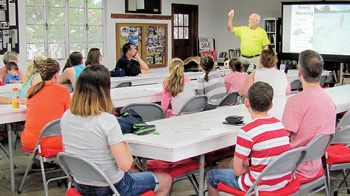Tuesday Turtle Talks launched

CINDY LANE | SUN
Above, Anna Maria Island Turtle Watch and Shorebird Monitoring
volunteer Bill George talks about turtles each Tuesday at the
Annie Silver Community Center. Right, a model of a sea turtle nest
shows hatchlings on their birthday.
BRADENTON BEACH – The first Tuesday Turtle Talk at Annie Silver Community Center drew about 25 people to learn about local efforts to save imperiled sea turtles.
Bill George, a 19-year volunteer with Anna Maria Island Turtle Watch and Shorebird Monitoring, told the group that it’s worth putting in the hours, even at age 77, to keep a species that’s 250 million years old from going extinct like the dinosaurs.
Threatened loggerheads are the most common sea turtle on Anna Maria Island, deriving their name from a legend that sailors thought they were logs floating in the water, he said. A few green turtles also are sighted here each year.
Others that nest elsewhere are leatherback, hawksbill and Kemp’s ridley turtles.
Sea turtles live a life span similar to humans – 80-100 years, and take up to 30 years before they can reproduce.
Nesting is not easy, George told the group, challenging kids to lie on their stomachs and drag themselves along the beach with their arms and legs like a turtle.
Turtles began nesting in April this year, a bit early, as the official start of turtle season is May 1, probably because April was warmer than usual, George said, adding that when the water is at least 80 degrees, nesting begins.
Mother turtles can nest several times each season. They come ashore at night, dig a shallow pit, then dig down two feet with their back flippers and lay their eggs, then cover up the nest with their back flippers and crawl back to the Gulf of Mexico. Last year each nest averaged 82 eggs.
“She tries to hide it from us, and she does a good job,” he said, adding that Turtle Watch volunteers go out each morning to spot tracks, carefully dig down to verify that eggs were laid and mark the nests to protect them.
Sometimes nests must be dug up and relocated because they are too close to the water, too close to the surface or, as in the case of two recent nests, too close to construction at Twin Piers, he said.
Nests are prey to raccoons, ghost crabs, ants and even people who rob the nests for the eggs, a federal offense.
About 60 days after the nest is laid, hatchlings emerge like lava from a volcano, heading for the sea, unless they are distracted by lights or other interference, he said.
They swim for floating grass beds in the Gulf, where they feed and grow, and are camouflaged.
One in 1,000 survive.
Thirty years or so later, the females return to the area where they hatched to nest. The males seldom, if ever, see land again.
Turtle Watch excavates hatched nests to count the number of shells and unhatched eggs, keeping statistics on the numbers. Tours of the excavations will be offered in July and August. Tuesday Turtle Talks will continue on Tuesdays at 10 a.m. through August.

